Every year at Book Expo America (BEA) one of my primary jobs at the show is trend-spotting, especially now that DIY MFA has begun featuring more guest content on our site. Book Expo is the main place where I connect with authors, publishers and industry professionals that we will feature over the coming year. But as you know, here at DIY MFA we like the books and authors we feature to tie together in some way. Hence the reason trend-spotting is so important. Here are some of the trends and themes I’ve noticed at Book Expo this year.
Books that are more than books.
 I’m referring to books that are more than just text on a page. These books use illustration, design or some interactive component in a creative way that makes the “book-ness” of it essential. I’ve said it before many times, but I don’t think digital will kill the printed word. But that doesn’t mean that printed books won’t have to “up the ante” in some way. For books to justify their printed existence, they’ll have to raise the bar in some way and these books definitely do that.
I’m referring to books that are more than just text on a page. These books use illustration, design or some interactive component in a creative way that makes the “book-ness” of it essential. I’ve said it before many times, but I don’t think digital will kill the printed word. But that doesn’t mean that printed books won’t have to “up the ante” in some way. For books to justify their printed existence, they’ll have to raise the bar in some way and these books definitely do that.
Books on my to-read list in this category include The Resurectionist by E.B. Hudspeth (Quirk Books), which depicts anatomically accurate pictures of fantastical creatures.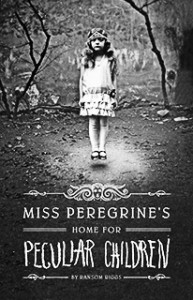

Miss Peregrine’s Home for Peculiar Children by Ransom Riggs (Quirk Books) which weaves a story based around peculiar vintage photographs, has been out since 2011. A graphic novel version is slated to be released in October 2013 (Hachette), taking this concept of a book that’s more than a book even further.
Often when we think of books that are “more than books” picture books immediately come to mind. This year, the ones I saw at BEA did not disappoint, with several raising the bar on this concept of “more than a book.”
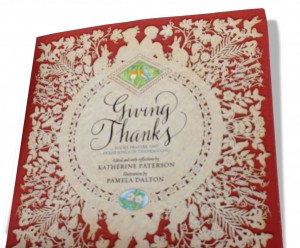 Journey by Aaron Becker (Candlewick) and Here I Am by Patti Kim and Illustrations by Sonia Sanchez (Capstone) show that wordless picture books are thriving. As a huge fan of David Wiesner’s Flotsam and Tuesday, I was thrilled to see more authors and illustrators taking on that challenge. An even bigger plus was getting an autographed limited edition print by Mr. Wiesner himself!
Journey by Aaron Becker (Candlewick) and Here I Am by Patti Kim and Illustrations by Sonia Sanchez (Capstone) show that wordless picture books are thriving. As a huge fan of David Wiesner’s Flotsam and Tuesday, I was thrilled to see more authors and illustrators taking on that challenge. An even bigger plus was getting an autographed limited edition print by Mr. Wiesner himself!
Other picture books, like Giving Thanks by Katherine Paterson (Illustrated by Pamela Dalton) and Inside Outside by Lizi Boyd (both from Chronicle) use cutouts in unique ways to illustrate and add to the story. The former features intricate paper cutout designs while the latter uses die-cut pages to create the contrast between inside and outside.
 And finally, Danse Macabre by Anna Harwell Celenza (Charlesbridge) includes a CD featuring the Saint-Saens piece by the same name and applies the same concept of last year’s Vivaldi’s Four Seasons to one of my favorite pieces of music. The music-lover in me can’t wait to check out this book.
And finally, Danse Macabre by Anna Harwell Celenza (Charlesbridge) includes a CD featuring the Saint-Saens piece by the same name and applies the same concept of last year’s Vivaldi’s Four Seasons to one of my favorite pieces of music. The music-lover in me can’t wait to check out this book.
This is just a small selection of the books I saw at BEA that fit this topic of “books that are more than books.” Another theme I noticed was the retelling of classic stories in new ways.
New Spin on Classic Stories

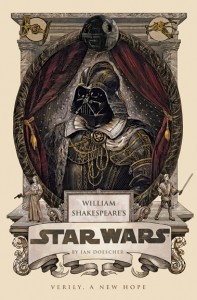 There was definitely a Shakespeare trend going on. I saw a Romeo & Juliet graphic novel by Gareth Hinds (Candlewick) and a retelling of Hamlet set in a prep school (A Wounded Name by Dot Hutchison, Carolrhoda Books). Not to menion, Quirk Books’ Shakespearean retelling of the Star Wars story.
There was definitely a Shakespeare trend going on. I saw a Romeo & Juliet graphic novel by Gareth Hinds (Candlewick) and a retelling of Hamlet set in a prep school (A Wounded Name by Dot Hutchison, Carolrhoda Books). Not to menion, Quirk Books’ Shakespearean retelling of the Star Wars story.
In addition to bard-inspired tales, there are other classic stories being retold in unique ways. In Rags & Bones Edited by Melissa Marr and Time Pratt (LB Teen), classic fairy tales and fables get a facelift from YA heavy-hitters like Neil Gaiman, Holly Black and others.
Show Highlights
 Aside from trend-spotting, this was one of the best BEA’s I’ve attended. For starters, it seemed less hectic than years past, and the ARC giveaways and signings were far more civilized. (I only got nearly-trampled once!) Joking aside, there were definitely some major highlights for me this year at BEA.
Aside from trend-spotting, this was one of the best BEA’s I’ve attended. For starters, it seemed less hectic than years past, and the ARC giveaways and signings were far more civilized. (I only got nearly-trampled once!) Joking aside, there were definitely some major highlights for me this year at BEA.
For the first time ever, I actually knew one of the people signing at BEA! It was so exciting and fun to see Betsy Bird signing her adorable picture book Giant Dance Party. I got a signed copy to bring home to my little man.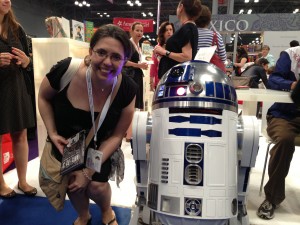
Major geek-out moment! I got my picture taken next to a life-size version of R2D2 at the Abrams booth.
Could Book Expo get any better than this?
Actually, yes.
OMG, I met Billy Collins!
I got to meet Billy Collins, one of my personal writing heroes and get an autographed copy of his new book. If you don’t know who Billy Collins is, please read this poem: Introduction to Poetry. Seriously, it’s not long. Go read it right now. I’ll wait.
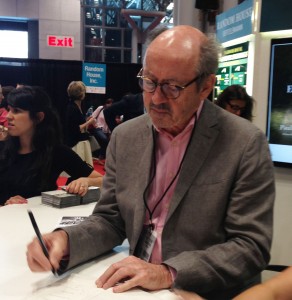 And while you’re at it, if you’ve ever participated in a writing workshop of some sort, then you must read this poem. Or listen to the recording of Mr. Collins reading it. Or both.
And while you’re at it, if you’ve ever participated in a writing workshop of some sort, then you must read this poem. Or listen to the recording of Mr. Collins reading it. Or both.
It was so inspiring to meet Billy Collins, even if it was only for the 2 minutes it took for him to sign his new book. I told him that I loved his poem “Workshop” and that I read it to students in my writing workshops. He chuckled and advised that I wait to share that poem at the end of the semester and I concurred.
Why was meeting Billy Collins such a highlight?
(You mean, aside from the fact that he’s a former Poet Laureate, that his poetry 180 program has helped high school students across America grow to love and understand modern poetry, and that his poems are just plain awesome?)
Let me explain. For a long time, I had a visceral distaste for poetry. I felt like the emotions were too angst-y the language was too flowery, that poets were trying to be too fancy-schmancy with their words because they didn’t know what they wanted to say. I felt like the purpose of poetry was to make people who didn’t “get” poetry (i.e. me) feel stupid. Needless to say, most poetry I read or heard at readings tended to make me quite angry.
Then I read “Introduction to Poetry” by Billy Collins and in that moment my whole perspective shifted. Suddenly I realized that poetry could be enjoyed just for what it is. That I don’t have to flog the meaning out of a poem and that it’s OK if I don’t really understand what the poet is trying to say. Most importantly, I realized that poetry can be smart and funny and complex without being complicated.







